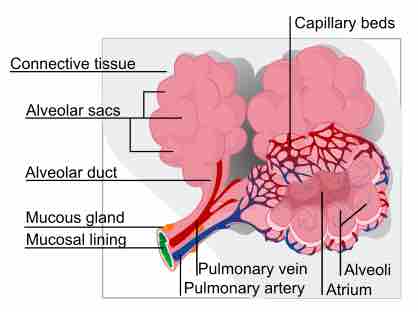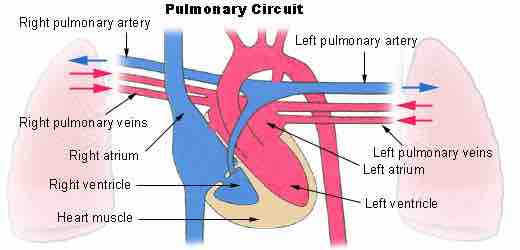The cardiovascular system is composed of two circulatory paths: pulmonary circulation, the circuit through the lungs where blood is oxygenated; and systemic circulation, the circuit through the rest of the body to provide oxygenated blood .
Pulmonary Circulation
Pulmonary circulation is the movement of blood from the heart to the lungs for oxygenation, then back to the heart again . Oxygen-depleted blood from the body leaves the systemic circulation when it enters the right atrium through the superior and inferior venae cavae. The blood is then pumped through the tricuspid valve into the right ventricle. From the right ventricle, blood is pumped through the pulmonary valve and into the pulmonary artery. The pulmonary artery splits into the right and left pulmonary arteries and travel to each lung. At the lungs, the blood travels through capillary beds on the alveoli where respiration occurs , removing carbon dioxide and adding oxygen to the blood. The alveoli are air sacs in the lungs that provide the surface for gas exchange during respiration. The oxygenated blood then leaves the lungs through pulmonary veins, which returns it to the left atrium, completing the pulmonary circuit. Once entering the left heart, the blood flows through the bicuspid valve into the left ventricle. From the left ventricle, the blood is pumped through the aortic valve into the aorta to travel through systemic circulation, delivering oxygenated blood to the body before returning again to the pulmonary circulation.

Alveoli
A diagram of the alveoli, illustrating the capillary beds where gas exchange with the blood occurs.

Pulmonary circuit
Diagram of pulmonary circulation. Oxygen-rich blood is shown in red; oxygen-depleted blood in blue.
Systemic Circulation
Systemic circulation is the movement of blood from the heart through the body to provide oxygen and nutrients, and bringing deoxygenated blood back to the heart. Oxygen-rich blood from the lungs leaves the pulmonary circulation when it enters the left atrium through the pulmonary veins. The blood is then pumped through the mitral valve into the left ventricle. From the left ventricle, blood is pumped through the aortic valve and into the aorta, the body's largest artery. The aorta arches and branches into major arteries to the upper body before passing through the diaphragm, where it branches further into arteries which supply the lower parts of the body. The arteries branch into smaller arteries, arterioles, and finally capillaries. Waste and carbon dioxide diffuse out of the cell into the blood, while oxygen in the blood diffuses out of the blood and into the cell. The deoxygenated blood continues through the capillaries which merge into venules, then veins, and finally the venae cavae, which drain into the right atrium of the heart. From the right atrium, the blood will travel through the pulmonary circulation to be oxygenated before returning gain to the system circulation. Coronary circulation, blood supply to the heart muscle itself, is also part of the systemic circulation.